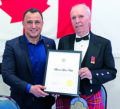General News » News
New fire hall, sports fields focus of Aurora’s 2017 Capital plan
October 6, 2016 · 0 Comments
By Brock Weir
A new fire hall on St. John’s Sideroad at Bayview Avenue and new sports facilities are among the top items up for discussion next week as Council gears up for talks on the 2017 Budget.
Deliberations over next year’s Capital Budget are set to begin next Saturday, October 15, at 9 a.m. in Council Chambers.
The Capital Budget is the first of two parts of your annual municipal budget focused largely on capital assets. The second half of the budget, which has a significant impact on your tax rate, is the Town’s Operations Budget, which will be tackled later this fall.
The fire hall, which will be overseen by Aurora but shared in cost with the Town of Aurora, is one of six items considered “large projects” in this year’s Capital Budget for Growth and New Infrastructure, along with a new change room building for the Aurora Youth Soccer Club, road and sidewalk construction on the St. John’s Sideroad East, replacement of a worn artificial turf field, and continued investment in the Town’s Wildlife Park.
The preliminary numbers were introduced at Council last week by Dan Elliott, Treasurer for the Town of Aurora, who said over the past year, the Town has grown to be a “half-billion dollar organization” accounting for net worth, with assets valued at $400 million, and the balance in cash and investments.
A particular factor in this growth, he said, is increased contributions from the tax rate to bolster reserves.
“In the early 2000s, we had a lot of fluctuations and what this caused was a lot of fluctuation in the tax rate increases, so it was volatile,” said Mr. Elliott, noting the years since Council put a plan in place to increase cash to capital reserves by one per cent each year. “It also made it tough to predict and tough to be a senior manager, and it probably made it difficult to be a politician in that period. In 2010, we began a steady pace. This is where our financial planning kicked it and said we needed increased contributions to reserves and we began increasing it every year since.
“It has been very stable, very steady, a little bit of fluctuation over a couple of years and as we go forward we are looking at that being able to drop down to .6 per cent instead of one per cent, so you can see in 2017 it is down there to . 6. This is allowing everyone in this room to have predictable and stable tax outlooks and assurance there is funding to look after our infrastructure in the future.”
As far as Aurora’s assets go compared to other municipalities, Mr. Elliott said ours are considered relatively “young,” giving the Town more time to build up the reserves as needed, in smaller steps than other municipalities. This gives Aurora longer time to plan for assets, he added, and long-term financial planning.
But, as always, there have been some bumps along the road. Since 2014, Aurora’s debt load has increased, largely attributed to shouldering the cost of the new Joint Operations Centre (JOC) recently completed on Industrial Parkway North, which serves as the new home to both the Town’s Parks and Recreation Department, as well as the Department of Public Works.
“We completed the JOC and we had a significant increase in our debt on that, so that is what triggered the change,” said Mr. Elliott. “It should be pretty stable to begin showing decline [in debt] in the coming years. [Our 10 year plan] includes increases to reserves and without it we would end the 10-year window with a negative 10 year reserve balance. We wouldn’t be anywhere near our targets and we’re not sustainable. That is why it is very important that we have those increments in place and part of our 10-year plan when those needs arise.”











